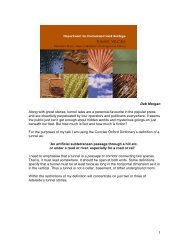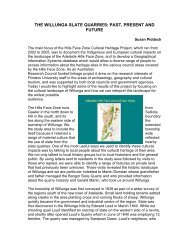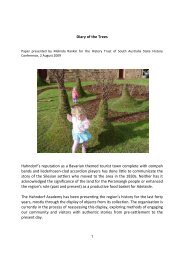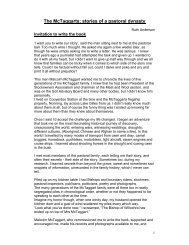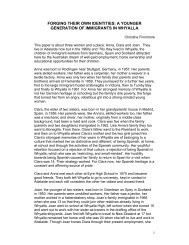Southward Bound Information - History SA
Southward Bound Information - History SA
Southward Bound Information - History SA
You also want an ePaper? Increase the reach of your titles
YUMPU automatically turns print PDFs into web optimized ePapers that Google loves.
Despite advice to the contrary many women joined ships knowing that they were<br />
likely to give birth while at sea.<br />
In the period 1836-1860 (and after) the birth of a child ashore was a considerable<br />
risk to mother and child, on board a ship at sea the chances of safe delivery and<br />
survival of either were infinitely less.<br />
SOCIAL INTERACTION:<br />
For many steerage passengers lack of privacy and enforced familiarity became a<br />
nightmare.<br />
Relationships between classes, sexes and families became strained and<br />
exaggerated, thrown together as the emigrants were and enduring the hazards<br />
and strictures of shipboard existence.<br />
Passengers had little opportunity of absenting themselves from each other’s<br />
company, except by retiring to their respective berths. Boisterous, quarrelsome<br />
passengers could upset the harmony for the entire voyage.<br />
OTHER:<br />
Loneliness - and/or boredom.<br />
Seasickness - could begin 2 hours after sailing and last for weeks as the vessel<br />
made its way south towards the equator.<br />
Panic - many of these people had never ventured beyond their homes in Britain.<br />
They were strangers to the sea and lived in a constant state of panic.<br />
Rats, lice and other vermin were a constant problem aboard the often dirty and<br />
poorly ventilated migrant vessels.<br />
THE NEW SHORE:<br />
As the ship neared the Australian mainland, it took a more northerly bearing (out of<br />
the roaring forties) and conditions began to improve for the passengers. Now<br />
everyone began to anticipate the possible day of arrival. Many of the trials and<br />
tribulations of the voyage were dismissed or forgotten as discussions about the<br />
future, speculations about conditions to be encountered and promised<br />
opportunities, began to exclude most other topics.<br />
Land, once sighted, caused excitement to reach fever pitch. It was usually<br />
Kangaroo Island that most people bound for South Australia first saw. Usually<br />
from K.I. it was only a matter of hours to Port Adelaide, after a voyage that was<br />
considered to have been performed in excellent time if it was under 100 days.<br />
Imagine the emotions of the migrants:<br />
* For all its discomforts, the ship offered a degree of security - one had few<br />
decisions to make, there was no isolation, no need yet to force a way for oneself.<br />
* Among steerage passengers life was ordered - they were assured of beds,<br />
assured of food and assured of a degree of medical attention.<br />
* For everyone on board, shore life had been suspended. One had only to submit<br />
to shipboard authority - and for most submission had been an accepted way of<br />
life back home.



